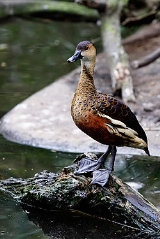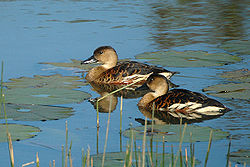
Wandering Whistling Duck
Encyclopedia
The Wandering Whistling Duck (Dendrocygna arcuata) is a species of whistling duck. They inhabit tropical and subtropical Australia, the Philippines, Indonesia, Papua New Guinea and the Pacific Islands . There are three subspecies associated with this bird. D. arcuata arcuata (Indonesian Wandering Whistling Duck), D. arcuata australis (Australian Wandering Whistling Duck), and D. arcuata pygmaea (New Britain Wandering Whistling Duck).
They have long necks and legs and look like a cross between a goose
and a duck
. They have a strong head and neck with a darker crown and hindneck. The breast contains black spotting and the feathers are mostly dark brown.
They range in size from 54–60 cm in height and weigh on average 750 grams. They mainly feed on grasses, waterlillies, water plants and occasionally insects and aquatic vertebrae.

Description
Formerly named Tree Ducks, the Wandering Whistling Duck have their new name because of their loud whistling calls and the whistling noise their wings make during flight.They have long necks and legs and look like a cross between a goose
Goose
The word goose is the English name for a group of waterfowl, belonging to the family Anatidae. This family also includes swans, most of which are larger than true geese, and ducks, which are smaller....
and a duck
Duck
Duck is the common name for a large number of species in the Anatidae family of birds, which also includes swans and geese. The ducks are divided among several subfamilies in the Anatidae family; they do not represent a monophyletic group but a form taxon, since swans and geese are not considered...
. They have a strong head and neck with a darker crown and hindneck. The breast contains black spotting and the feathers are mostly dark brown.
They range in size from 54–60 cm in height and weigh on average 750 grams. They mainly feed on grasses, waterlillies, water plants and occasionally insects and aquatic vertebrae.
Habitat
The Wandering Whistling Duck lives in deep lagoons, flooded grasslands or dams. They enjoy the water and rarely leave the shore. They can swim and dive with ease.Breeding
Breeding occurs during the tropical wet season usually between December and May. During this time six to fifteen eggs are laid in a nest not far from water and usually in high grass or a sheltered area.

